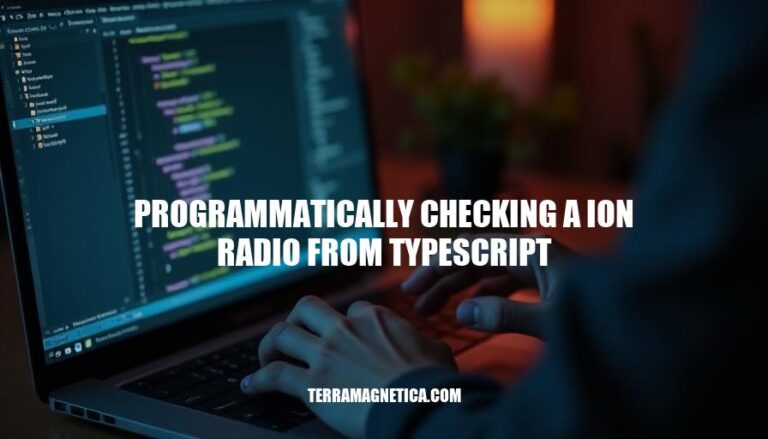


Programmatically checking an ion-radio using TypeScript involves setting the value of the radio button within a radio group dynamically through code. This technique is crucial in modern web development as it enhances user experience by allowing developers to control form elements based on user interactions or other logic. It ensures that the UI remains responsive and interactive, providing a seamless experience across different devices and platforms.
Install Node.js and npm:
node -v and npm -v.Set up a new project:
mkdir my-ionic-project && cd my-ionic-project.npm init -y.Install TypeScript:
npm install -g typescript.npm install --save-dev typescript.Install Ionic CLI:
npm install -g @ionic/cli.Create a new Ionic project:
ionic start myApp blank --type=angular.cd myApp.Install necessary libraries:
npm install @ionic/angular @angular/forms.Set up TypeScript configuration:
tsconfig.json in the project root:{
"compilerOptions": {
"target": "es5",
"module": "commonjs",
"strict": true,
"esModuleInterop": true,
"skipLibCheck": true,
"forceConsistentCasingInFileNames": true
}
}
Create a component for the ion-radio:
ionic generate component RadioComponent.radio.component.html:<ion-radio-group [(ngModel)]="selectedValue">
<ion-list-header>
<ion-label>Radio Group</ion-label>
</ion-list-header>
<ion-item>
<ion-label>Option 1</ion-label>
<ion-radio slot="start" value="option1"></ion-radio>
</ion-item>
<ion-item>
<ion-label>Option 2</ion-label>
<ion-radio slot="start" value="option2"></ion-radio>
</ion-item>
</ion-radio-group>
radio.component.ts:import { Component } from '@angular/core';
@Component({
selector: 'app-radio',
templateUrl: './radio.component.html',
styleUrls: ['./radio.component.scss']
})
export class RadioComponent {
selectedValue: string;
constructor() {
this.selectedValue = 'option1';
}
checkRadio() {
console.log(this.selectedValue);
}
}
Add FormsModule to your app module:
app.module.ts:import { FormsModule } from '@angular/forms';
@NgModule({
declarations: [AppComponent, RadioComponent],
imports: [BrowserModule, IonicModule.forRoot(), AppRoutingModule, FormsModule],
bootstrap: [AppComponent]
})
export class AppModule {}
Run the application:
ionic serve.This setup will allow you to programmatically check the value of an ion-radio in a TypeScript-based Ionic project.
To create an ion-radio component and programmatically check it using TypeScript, follow these steps:
Install Ionic Framework:
npm install @ionic/angular
Create the Radio Component:
<ion-radio-group [(ngModel)]="selectedValue">
<ion-item>
<ion-label>Option 1</ion-label>
<ion-radio slot="start" value="option1"></ion-radio>
</ion-item>
<ion-item>
<ion-label>Option 2</ion-label>
<ion-radio slot="start" value="option2"></ion-radio>
</ion-item>
</ion-radio-group>
Component TypeScript:
import { Component } from '@angular/core';
@Component({
selector: 'app-radio-example',
templateUrl: './radio-example.component.html',
styleUrls: ['./radio-example.component.scss'],
})
export class RadioExampleComponent {
selectedValue: string;
constructor() {
this.selectedValue = 'option1'; // Default checked value
}
checkRadio(value: string) {
this.selectedValue = value;
}
}
Programmatically Check a Radio:
// In your component class
this.checkRadio('option2'); // This will check the radio with value 'option2'
This setup ensures that the radio button with the value 'option2' is checked programmatically.
Here’s how you can programmatically check an ion-radio in an Ionic/Angular application using TypeScript.
Set Up Your HTML Template:
Define your radio buttons within an ion-radio-group. Use ngModel to bind the selected value.
<ion-list>
<ion-radio-group [(ngModel)]="selectedValue">
<ion-item>
<ion-label>Option 1</ion-label>
<ion-radio slot="start" value="option1"></ion-radio>
</ion-item>
<ion-item>
<ion-label>Option 2</ion-label>
<ion-radio slot="start" value="option2"></ion-radio>
</ion-item>
</ion-radio-group>
</ion-list>
Define Your Component Class:
In your TypeScript file, define the selectedValue property and a method to programmatically check a radio button.
import { Component } from '@angular/core';
@Component({
selector: 'app-radio-example',
templateUrl: './radio-example.component.html',
styleUrls: ['./radio-example.component.scss'],
})
export class RadioExampleComponent {
selectedValue: string;
constructor() {
// Initialize with a default value if needed
this.selectedValue = 'option1';
}
// Method to programmatically check a radio button
checkRadio(value: string) {
this.selectedValue = value;
}
}
Use the Method to Check a Radio Button:
You can call the checkRadio method from your template or any other method in your component to change the selected radio button.
<ion-button (click)="checkRadio('option2')">Select Option 2</ion-button>
HTML Template:
ion-radio-group directive binds the radio buttons to the selectedValue property using ngModel.ion-radio has a value attribute that corresponds to the value you want to set programmatically.Component Class:
selectedValue property holds the currently selected radio button’s value.checkRadio method updates the selectedValue property, which in turn updates the selected radio button in the template.Programmatic Selection:
checkRadio method with the desired value, you can programmatically select a radio button.This approach ensures that the radio button selection is dynamically updated based on the value set in the component class.
Unit Testing:
ion-radio component.checked state changes as expected.Integration Testing:
ion-radio component and verify the outcomes.Debugging:
ion-radio selection logic.Performance Testing:
ion-radio component does not degrade the application’s performance.ion-radio components are rendered.Code Coverage:
ion-radio component are tested.Continuous Integration:
These methods will help ensure the reliability and performance of your ion-radio component in a TypeScript environment.
To programmatically check an ion-radio component from TypeScript, you need to understand how to bind the radio buttons to a property using ngModel and update that property in your component class. This involves creating an HTML template with ion-radio-group and ion-radio directives, and a component class with a selectedValue property and a checkRadio method.
By calling the checkRadio method with the desired value, you can dynamically select a radio button.
Unit testing is crucial to ensure the logic of checking the ion-radio component works as expected. You should write unit tests using frameworks like Jest or Mocha to mock dependencies and test the checked state changes.
Integration testing helps verify that the correct radio button is selected when a specific action is performed. Use tools like Cypress or Protractor for end-to-end testing.
Debugging is essential to identify any issues with the ion-radio component’s selection logic. Utilize Visual Studio Code’s debugging tools to set breakpoints and inspect the state and flow of your code.
Performance testing measures the impact on application performance when using the ion-radio component. Use tools like Lighthouse or WebPageTest to ensure it does not degrade performance.
Code coverage is vital to ensure all critical paths and edge cases for the ion-radio component are tested. Use tools like Istanbul to measure test coverage and verify that all branches of the selection logic are covered by tests.
Continuous integration ensures ongoing reliability by automatically running tests on each commit. Integrate your tests into a CI/CD pipeline using tools like GitHub Actions or Jenkins to set up a pipeline to run unit and integration tests on every push to the repository.